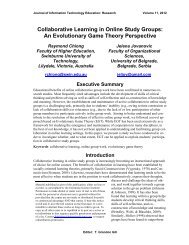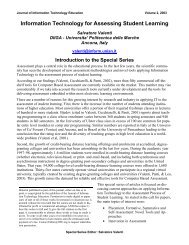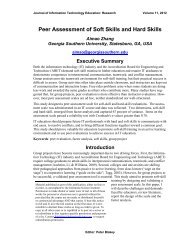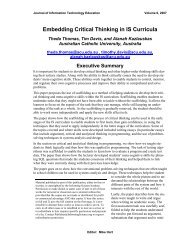Does Math Achievement h'APP'en when iPads and Game-Based ...
Does Math Achievement h'APP'en when iPads and Game-Based ...
Does Math Achievement h'APP'en when iPads and Game-Based ...
Create successful ePaper yourself
Turn your PDF publications into a flip-book with our unique Google optimized e-Paper software.
The Impact of <strong>iPads</strong> on <strong>Math</strong> <strong>Achievement</strong><br />
<strong>Based</strong> on the design of the study <strong>and</strong> the reported data, experiences with <strong>iPads</strong> were not meaningful<br />
enough to significantly influence students’ mathematics achievement. This finding indicates<br />
that instruction with the supplemental use of the iPad was not an effective intervention for fifthgrade<br />
students’ mathematics achievement according to the manner in which the current investigation<br />
was conducted. These findings are aligned with existing studies in which 1:1 mobile learning<br />
devices, like the iPad, were not shown as influential on student achievement.<br />
The following three studies 1:1 initiatives found no relationship with student achievement.<br />
Members of the Texas Center for Educational Research (2009) examined the long-term effect of<br />
1:1 laptops on student learning using 21 middle schools in the experimental group with a 1:1 laptop<br />
initiative <strong>and</strong> 21 middle schools in the control group without a 1:1 laptop initiative. Over a<br />
period of three years, the results showed no statistical significance in mathematics achievement<br />
on state st<strong>and</strong>ardized testing for the majority of the population. In addition, Hu (2007) reported<br />
findings of numerous school districts in New York, Massachusetts, California, Virginia, Florida,<br />
<strong>and</strong> Texas whose administrators have found no overall difference in students’ academic achievement<br />
<strong>when</strong> using a 1:1 laptop initiative. According to Holcomb (2009), schools nationwide are<br />
ab<strong>and</strong>oning 1:1 mobile device initiatives due to lack of results <strong>and</strong> astronomical upkeep costs.<br />
One of the most desired results of a 1:1 mobile initiative is the increase of st<strong>and</strong>ardized achievement<br />
test scores (Rockman, 2004); yet, a disconnect may exist between st<strong>and</strong>ardized assessments<br />
like the SFAW Virginia SOL aligned assessment <strong>and</strong> the benefits of using 1:1 mobile devices<br />
(Holcomb, 2009; Rockman, 2004). Rockman (2004), who had evaluated more than 50 school<br />
district’s technology implementation studies, found only “isolated examples of test score increases<br />
but they are slippery: neither consistent nor necessarily tied to the use of computers” (p.<br />
37). Although the use of 1:1 mobile devices showed promise to assist students in 21st-century<br />
learning skills, Holcomb (2009) stated that in using a 1:1 initiative, “it is important to recognize<br />
the existing st<strong>and</strong>ardized assessment may be ill equipped to measure 21st century learning” (p.<br />
54). It is possible the SFAW Virginia SOL aligned assessment was ill equipped for measurement<br />
of students’ 21st-century learning.<br />
The data suggests the iPad intervention did not have a statistically significant impact on students’<br />
mathematics achievement. The study duration could be an explanation for the insignificant impact.<br />
Of all of the technology intervention achievement-based studies referenced throughout the<br />
present study, 50% of interventions occurred for less than one academic semester; thus, the current<br />
study duration was aligned with existing research. In implementing a 1:1 initiative, school<br />
leaders must maintain realistic expectations that the intervention results might not be immediate<br />
(Holcomb, 2009). Educators must learn how to effectively use new classroom technology such<br />
that Silvernail <strong>and</strong> Gritter (2004) claimed up to eight years might be required for an identifiable<br />
implementation effect.<br />
Due to state testing <strong>and</strong> available materials, the current research study could only occur within<br />
one academic quarter. During this experiment, 45 weekdays passed, but only 40 days were feasible<br />
to complete the study due to snow days, teacher workdays, school assemblies, state testing,<br />
<strong>and</strong> field trips. Students in the experimental group used the <strong>iPads</strong> daily for the academic quarter.<br />
The participating teacher recorded the accuracy with which the lesson plans were followed on the<br />
LPAR.<br />
<strong>Based</strong> on the LPAR, the experimental group’s lesson plans were accurately implemented <strong>and</strong> all<br />
students used the <strong>iPads</strong> 85% of the study’s possible 40 days. On 10% of the study’s days in<br />
which the majority of the lesson plan was implemented, not all students used the <strong>iPads</strong> during the<br />
mathematics lesson. For 5% of the study’s possible days, students did not use the iPad during the<br />
mathematics lesson. The LPAR sheds light on the additional days students did not have the opportunity<br />
to use the iPad in mathematics class, lowering the total days to 32 days or an intermit-<br />
278










